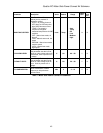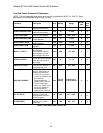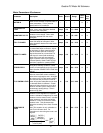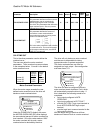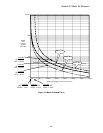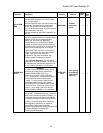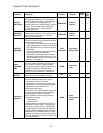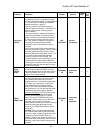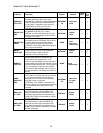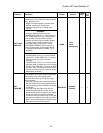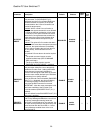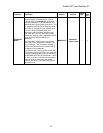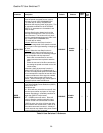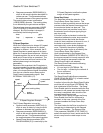
Quattro DC User Switches C1
Parameter Description Default Choices
Hidden
Item
Run
lock
out
PreTorque
LATCH
(PreTorque Latch) If Pre-Torque latching is
NOT selected, the Pre-Torque signal must be
valid when the speed regulator is commanded to
run. For verification on timing, see NORMAL
operating sequence on page 21.
Some car controllers send both analog pre-
torque and speed commands . To facilitate this,
the Drive has the option of latching the pre-
torque command.
If pre-torque latching is selected using the Pre-
Torque Latch parameter, a FALSE to TRUE
transition on the pre-torque latch clock latches
the value on the pre-torque channel into the
drive. This channel is allowed to change any
time except during this transition without
affecting the value of the latched pre-torque
command
.
The Pre-Torque Latch Clock controls when the
pre-torque command is latched. The Pre-Torque
Latch clock parameter (Ptorq LATCH CLCK)
determines the source of this latch control. The
two choices for latch control are the serial
channel or a logic input (EXTERNAL TB).
The speed regulator uses the latched pre-torque
command when the internal Speed Regulator
Release signal is asserted. Once the pre-torque
command is used, the latch and the pre-torque
command are cleared.
NOT
LATCHED
− latched
− not latched
Y Y
Ptorq
LATCH
CLCK
(Pre-Torque Latch Clock) If the PRE-TORQUE
LATCH has been set to LATCHED, then this
parameter chooses the source for latch control.
If set to EXTERNAL TB1, the Pre-Torq Latch
signal on TB1 must be selected.
EXTERNAL
TB
− external tb
− serial
Y Y
FAULT
RESET SRC
(Fault Reset Source)
This parameter determines the source of the
drive’s external fault reset from one of the
following sources: an external fault reset signal
from a logic input (external tb), a fault reset
signal transferred across a serial channel
(serial), or the drive automatically resets the
faults (automatic). The user also has the option
to reset faults directly through the operator.
Automatic Fault Reset:
If the fault reset source
is set to automatic, the faults will be reset
according to the setting of the FLT RESET
DELAY (A1) and FLT RESETS/HOUR (A1)
parameters. When a logic input is defined as
“fault reset” and this logic input signal is
transitioned from false to true: an active fault will
be reset and automatic fault reset counter
(defined by FLT RESETS/HOUR(A1)) will be
reset to zero.
CAUTION: If the run signal is asserted at the
time of a fault reset, the drive will immediately
go into a run state. Unless using the auto-fault
reset function (FAULT RESET SRC (C1) =
automatic), then the run command needs to be
cycled to be reset automatically, but will reset if
initiated by a logic input without cycling the run
command.
EXTERNAL
TB
− external tb
− serial
− automatic
Y Y
53



